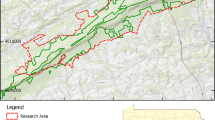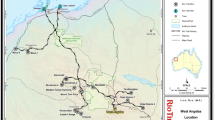Abstract
This paper discusses the results of terrestrial laser scanning combined with close range photogrammetry of the common beeches (Fagus sylvatica) covered in carvings (arborglyphs) dated to 1944 around Chycina, Poland. First, the archaeological research concerning heritage in the woodlands is shortly outlined using Polish archaeology as a case study. Then, the limitations of such research are pointed out. The last two parts of this paper present the beeches as a unique example of living monuments of the recent past. It is argued that archaeologies of the recent past in the woodlands will be gaining an increasing relevance in Polish as well as European archaeology.















Similar content being viewed by others
References
Ariosto, L. (2009). Orlando Furioso. Slavitt, D. R. (trans.). Harvard University Press, Cambridge, MA.
Bennett, J. (2010). Vibrant Matter: A Political Ecology of Things. Duke University Press, Durham, NC.
Bronner, S. J. (1985). Chain Carvers: Old Men Crafting Meaning. University Press of Kentucky, Lexington.
Burström, M. and Gelderblom, B. (2009). Dealing with difficult heritage: the case of Bückeberg, site of the Third Reich harvest festival. Journal of Social Archaeology 11(3): 266–282.
Burton, J. T. and Farrell, M. M. (2013). “Life in Manzanar where there is a spring breeze”: graffiti at a World War II Japanese American internment camp. In Mytum, H. and Carr, G. (eds.), Prisoners of War: Archaeology, Memory, and Heritage of 19th- and 20th-Century Mass Internment. Springer, New York, pp. 239–270.
Capps Tunwell, D., Passmore, D. G., and Harrison, S. (2015). Landscape archaeology of World War Two German logistics depots in the Forêt domaniale des Andaines, Normandy, France. International Journal of Historical Archaeology 19(2): 233–261.
Casella, E. (2009). Written on the walls: inmate graffiti within places of confinement. In Beisaw, A. M. and Gibb, J. G. (eds.), The Archaeology of Institutional Life. University of Alabama Press, Tuscaloosa, pp. 172–186.
Charmaz, K. (2006). Constructing Grounded Theory: A Practical Guide through Qualitative Analysis. Sage Publications Ltd, London.
Chmielewski, A. (2013). MRU. Historia i Współczesność. Wydawnictwo Literat, Międzyrzecz.
Derrida, J. (1978). Writing and Difference. Bass, A. (trans.). University of Chicago Press, Chicago.
Edgeworth, M. (2011). Fluid Pasts: Archaeology of Flow. Bristol Classical Press, Bristol.
Forte, M., Dell’Unto, N., Issavi, J., Onsurez, L., and Lercari, N. (2012). 3D archaeology at Çatalhöyük. International Journal of Heritage in the Digital Era 1(3): 351–378.
Giles, K. and Giles, M. (2010). Signs of the times: nineteenth- and twentieth-century graffiti in the farms of the Yorkshire words. In Oliver, J. and Neal, T. (eds.), Wild Sings: Graffiti in Archaeology and History. Archaeopress, Oxford, pp. 47–59.
González-Ruibal, A. (2012). From the battlefield to the labour camp: archaeology of civil war and dictatorship in Spain. Antiquity 86(332): 456–473.
Haraway, D. (2003). The Companion Species Manifesto: Dogs, People, and Significant Otherness. Prickly Paradigm Press, Chicago.
Harrison, R. (2013). Heritage: Critical Approaches. Routledge, London.
Harrison, R. (2015). Beyond “natural” and “cultural” heritage: towards an ontological politics of heritage in the age of Anthropocene. Heritage and Society 8(1): 24–42.
Herva, V. P. (2014). Haunting heritage in an enchanted land: magic, materiality and Second World War German material heritage in Finnish Lapland. Journal of Contemporary Archaeology 1(2): 297–321.
Hesse, R. (2013). The changing picture of archaeological landscapes: LiDAR prospection over very large areas as part of a cultural heritage strategy. In Opitz, R. S. and Cowley, D. C. (eds.), Interpreting Archaeological Topography. Oxbow Books, Oxford, pp. 171–183.
Holden, N., Horne, P., and Bewley, R. (2002). High-resolution digital airborne mapping and archaeology. In Bawley, R. and Rączkowski, W. (eds.), Aerial Archaeology: Developing Future Practice NATO Science Series, sub-series I: Life and Behavioural Sciences, IOS Press, Amsterdam, pp. 173–180.
Holtorf, C. (2015a). Are we all archaeologists now? Journal of Contemporary Archaeology 2(2): 217–219.
Holtorf, C. (2015b). Averting loss aversion in cultural heritage. International Journal of Heritage Studies 21(4): 405–421.
Irlinger, W. and Suhr, G. (eds.) (2017). Archaeological Sites in Forests: Strategies for the Protection. Volk Verlag München, München.
Jurga, G. and Kędryna, A. (2000). Festungsfront Oder-Warthe-Bogen. Katalog. Wydawnictwo Donjon, Cracow.
Kajda, K. and Frąckowiak, M. (2017). Duchy miejsca – napisy (graffiti) w przestrzeniach publicznych i prywatnych jako przedmiot badań archeologii współczesnej przeszłości. Acta Universitatis Lodziensis. Folia Archaeologica 32: 31–45.
Karczewski, M. and Karczewska, M. (2014). Archeologia I wojny światowej na giżyckim odcinku frontu wschodniego. In Kempa, R. (ed.), Wielka Wojna na Mazurach 1914–1915. Studia z Dziejów Frontu Wschodniego I Wojny Światowej. Towarzystwo Miłośników Twierdzy Boyen, Giżycko, pp. 393–403.
Knapp, H. D. and Fichtner, A. (2011). Beech Forests: Joint Natural Heritage of Europe. Bundesampt für naturschutz (BfN), Federal Agency for Nature Conservation, Bonn.
Knight, L. (2014). Reading Green in Early Modern England. Ashgate, Farnham.
Kobiałka, D., Frąckowiak, M., and Kajda, K. (2015). Tree memories of the Second World War: a case study of common beeches from Chycina, Poland. Antiquity 89(345): 683–696.
Kobiałka, D., Kostyrko, M., and Kajda, K. (2017a). The Great War and its landscapes between memory and oblivion: the case of prisoners of war camps in Tuchola and Czersk, Poland. International Journal of Historical Archaeology 21(1): 134–151.
Kobiałka, D., Kajda, K., and Frąckowiak, M. (2017b). Wspomnienia drzew. Archeologia Żywa 3(65): 48–51.
Konczewski, P., Konczewska, M., Sady, A., Szczurkowski, J., and Wroniecki, P. (2016a). Krajobraz kulturowy i paleoekologia Puszczy Zgorzeleckiej. Badania w lennictwach Toporów i Zabłocie. Śląskie Sprawozdania Archeologiczne 58: 199–226.
Konczewski, P., Szczurowski, J., Wroniecki, P., Mackiewicz, M., and Zawadzki, P. (2016b). Projekt badawczy Tormersdorf-Toporów. Mieszkańcy, kultura i środowisko przyrodnicze zanikłego mikroregionu osadniczego na Górnych Łużycach. In Nocuń, P., Przybyła-Dumin, A., and Fokl, K. (eds.), Wieś Zaginiona. Stan i Perspektywy Badań. Muzeum “Górnośląski Park Etnograficznych w Chorzowie”, Chorzów, pp. 147–172.
Kostyrko, M., Kajda, K., Wroniecki, P., and Lokś, A. (2016a). Archeologia nieinwazyjna w lesie. Prospekcja wczesnośredniowiecznego grodziska w Biedrzychowicach Dolnych woj. lubuskie. Śląskie Sprawozdania Archeologiczne 58: 85–99.
Kostyrko, M., Kajda, K., Kobiałka, D., and Mlekuž, D. (2016b). An archaeological flight further than post-processualism – seeking a non-anthropocentric perspective. AARGnews: The Newsletter of the Aerial Archaeology Research Group 52: 71–79.
Kujawka, E. (2016). Po drzewach. In Raba, K., Rozwadowski, A., and Gruszczyński, Ł. eds., Ślady. Spacer z Powidokiem. Uniwersytet Artystyczny w Poznaniu, Poznań, pp. 43–73.
Latour, B. (1993). We have Never Been Modern. Porter, C. (trans.). Harvard University Press, Cambridge, MA.
Latour, B. (2005). Reassembling the Social: An Introduction to Actor-Network-Theory. Oxford University Press, Oxford.
Lee, R. W. (1977). Names on Trees: Ariosto into Art. Princeton University Press, Princeton, NJ.
Lerma, J. L., Navarro, S., Cabrelles, M., and Villaerde, V. (2010). Terrestrial laser scanning and close range photogrammetry for 3D archaeological documentation: the Upper Paleolithic Cave of Parpalló as a case study. Journal of Archaeological Science 37(3): 499–507.
Lo Brutto, M. and Meli, P. (2012). Computer vision tools for 3D modelling in archaeology. International Journal of Heritage in the Digital Era 1(1): 1–6.
Lovata, T. (2015). Marked trees: exploring the context of Southern Rocky Mountain arborglyphs. In Loyata, T. and Olton, E. (eds.), Understanding Graffiti. Multidisciplinary Studies from Prehistory to the Present. Routledge, London, pp. 91–104.
Lovata, T. and Olton, E. (eds.) (2015). Understanding Graffiti: Multidisciplinary Studies from Prehistory to the Present. Routledge, London.
Małczyński, J. (2010). Trees as living monuments at the Museum-Memorial Site at Bełżec. In Majewski, T., Zeidler-Janiszewska, A., and Wójcik, M. (eds.), Memory of the Shoah: Cultural Representations and Commemorative Practices. Oficyna, Łódź, pp. 35–41.
Mallea-Olaetxe, J. (2000). Speaking Through the Aspens: Basque Tree Carvings in California and Nevada. University of Nevada Press, Reno.
Miniewicz, J. and Perzyk, B. (2012). Międzyrzecki Rejon Umocniony. Militaria Bogusława Perzyka, Warszawa.
Oliver, J. and Neal, T. (2010). Elbow grease and time to spare: the place of tree carving. In Oliver, J. and Neal, T. (eds.), Wild Sings: Graffiti in Archaeology and History. Archaeopress, Oxford, pp. 15–22.
Olsen, B. (2010). In Defense of Things: Archaeology and the Ontology of Objects. Altamira Press, Lanham, MD.
Olsen, B., Shanks, M., Webmoor, T., and Witmore, C. (2012). Archaeology: The Discipline of Things. University of California Press, Berkeley.
Passmore, D. G., Harrison, S., and Capps Tunwell, D. (2014). Second World War conflict archaeology in the forests of north-west Europe. Antiquity 88(342): 1275–1290.
Pearson, C. (2015). Beyond ‘resistance’. Rethinking nonhuman agency for a ‘more-than-human’ world. European Review of History/Revue Européenne d’Histoire 22(5): 709–725.
Pétursdóttir, Þ. (2012). Small things forgotten now included, or what else do things deserve? International Journal of Historical Archaeology 16(3): 577–603.
Pilichowski, C. (ed.) (1979). Obozy Hitlerowskie na Ziemiach Polskich 1939–1945. Państwowe Wydawnictwo Naukowe, Warszawa.
Piovesan, G., Alessandrini, A., Baliva, M., Chiti, T., D’Andrea, E., De Cinti, B., Di Filippo, A., Hermanin, L., Lauteri, M., Scarascia Mugnozza, G., Schirone, B., Ziaco, E., and Matteucci, G. (2010). Structural patterns, growth processes, carbon stocks in an Italian network of old-growth beech forests. Italian Journal of Forest and Mountain Environments 65(5): 557–590.
Shackel, P. A. and Chambers, E. (eds.) (2004). Places in Mind: Public Archaeology as Applied Anthropology. Routledge, London.
Shanks, M. (2007). Symmetrical archaeology. World Archaeology 39(4): 589–596.
Shanks, M. (2008). Post-processual archeology and after. In Bentley, A. R., Maschner, H. D., and Chippindale, C. (eds.), Handbook of Archaeological Theories. Altamira Press, Lanham, pp. 133–144.
Shanks, M. and Tilley, C. (1987). Re-constructing Archaeology. Cambridge University Press, Cambridge.
Spring, A. P. and Peters, C. (2014). Developing a low cost 3D imaging solution for inscribed stone surface analysis. Journal of Archaeological Science 52: 97–107.
Summerfield, C. (2010). Trees as a living museum: arborglyphs and conflict on Salisbury Plain. In Saunders, N. (ed.), Beyond the Dead Horizon: Studies in Modern Conflict Archaeology. Oxford University Press, Oxford, pp. 159–171.
Thomas, J. (2004). Archaeology and Modernity. Routledge, New York.
Tomanek, J. (1997). Botanika Leśna. Państwowe Wydawnictwo Rolnicze i Leśne, Warszawa.
Trigger, B. (2006). A History of Archaeological Thought. 2nd ed. Cambridge University Press, Cambridge.
Wijnen, J. (2011). Sporen van de Tweede Wereldoorlog in het landschap. Vakblad Natuur Bos Landschap 5(8): 4–7.
Witmore, C. (2017). Complexities and emergence: the case of Argos. In Knodell, A. R. and Leppard, T. P. (eds.), Regional Approaches to Society and Complexity, Equinox eBook Publishing, Sheffield, pp. 268–287.
Wroniecki, P., Jaworski, M., and Kostyrko, M. (2015). Exploring free LiDAR derivatives. A user’s perspective on the potencial of readily available resources in Poland. Archaeologia Polona 53: 611–616.
Zapłata, R. and Stefańczy, K. (2016). Puszcza Białowieska, LiDAR i dziedzictwo kulturowe – zagadnienia wstępne. Raport 11: 239–255.
Zapłata, R., Szady, B., and Stefańczyk, K. eds. (2014). Laserowi Odkrywcy–Nieinwazyjne Badania i Dokumentowanie Obiektów Archeologicznych i Historycznych Województwa Świętokrzyskiego. Fundacja Centrum GeoHistorii, Babice.
Acknowledgments
Many people helped me during the research. I would like to thank Kornelia Kajda and Maksymilian Frąckowiak for joint research on the archaeology of tree carvings. Acknowledgements go also to the company “Gispro Sp. z o.o.” which scanned the trees with carvings near Chycina. Grzegosz Szalast from “ArchService” helped me with the visualizations of panels of the trees. Mikołaj Kostyrko gave me the permission to use the air photo (Fig. 2) in this article which was found during his research at the National Archives and Records Administration, USA. Sketchfab offered me a free account on its portal where the 3D models of trees can be viewed and approached by the public, for which I would like to thank. A big thank you to my wife Anna Kobiałka who graphically refined figures to this article. Last but not least, Kazimierz Raba kindly allowed me to use his installations created as part of the Signs of Nature, Signs of Culture (Fig. 5). Finally, I thank two anonymous reviewers for their careful reading of the manuscript and their many insightful comments and suggestions. However, I remain entirely responsible for any simplifications and errors.
Funding
This work is part of my research financed by the National Science Centre, Poland on the basis of decision no. DEC-2016/20/S/HS3/00001.
Author information
Authors and Affiliations
Corresponding author
Ethics declarations
Conflict of Interest
The author declares that he has no conflict of interest.
Additional information
The 3D models of trees with carvings are accessible at the following websites:
Rights and permissions
About this article
Cite this article
Kobiałka, D. Living Monuments of the Second World War: Terrestrial Laser Scanning and Trees with Carvings. Int J Histor Archaeol 23, 129–152 (2019). https://doi.org/10.1007/s10761-018-0462-5
Published:
Issue Date:
DOI: https://doi.org/10.1007/s10761-018-0462-5




